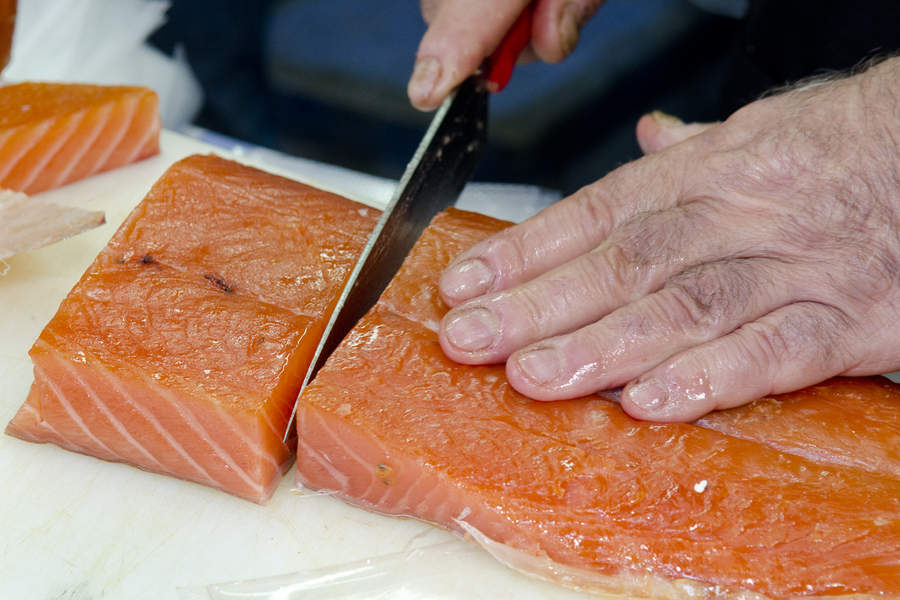Make Sushi from Costco Salmon and Seafood
One of the most common questions we get here at Sushi Modern is whether you can make sushi from Costco fish. For many, this is the best, freshest source of fish available to them, which is what we always recommend when buying fish for sushi.

Costco has everything you’d expect from a quality fish monger: trustworthy labeling, high volume, movement of product, and fresh fish that never sits for too long. But is it safe to eat? Or is it “sushi-grade?” The short answer is yes, you can make sushi from some Costco fish. The longer answer is that you must be comfortable with a certain level of risk and we recommend taking a look at our safe sushi guide for a better answer to these questions.
In short, certain species of fish are highly susceptible to parasites that migrate from the fish’s belly into the flesh we eat. When we eat these live parasite larvae, they will try to embed themselves in our stomach or intestine linings before dying, causing our bodies to violently react and make us sick. Even though the infection rate is extremely rare (only 60 reported cases in the U.S.), the illness can be very severe. Salmon is one such fish susceptible to these parasites.
Buying Guide
Use this buying guide at your local Costco to know what to shop for—and what to avoid—when shopping for sushi. Remember to always buy as fresh as possible and avoid fish labeled as "wild" to reduce risk of parasites.
Salmon / Samon
Parasite Risk: high (wild), low (farmed)
Costco stocks several types of salmon depending on your location:
- Sockeye salmon
- Steelhead salmon
- King salmon
Usually this fish is fresh and high-quality, processed both quickly and cleanly. When shopping for salmon for sushi, look for “farmed Atlantic salmon” or “farmed Alaskan salmon.” It’s essential that you only use farmed salmon for sushi, since salmon—especially wild salmon—is a high risk for parasites. Farmed salmon is raised on feed pellets, preventing them from eating parasite-infected prey. In a survey of 37 salmon farms, there was no incidence of parasites found. Even though wild salmon tastes better, it must be flash frozen to destroy parasites in the flesh; Costco does freeze its salmon, but does not meet FDA guidelines for parasite destruction.
Scallops / Hotate
Parasite Risk: none
Scallops are an excellent choice for sushi, typically served as nigiri, perhaps with a pinch of salt and squeeze of citrus. Be sure you only buy dry scallops, which are untreated with sodium tripolyphosphate, a phosphate salt which causes them to absorb water. Wet scallops taste like nothing and have an unappetizing mushy texture.
To make hotate (scallop) nigiri, simply slide the knife lengthwise across half the scallop body to butterfly it. Then prepare your rice ball and shape into nigiri just as you would with any other fish.
Tuna / Maguro
Parasite Risk: none
Tuna is typically sold in the form of Ahi tuna steaks, which are difficult to slice for nigiri and sashimi. The steaks are cut against the grain, meaning your slices are going to be cut with the grain, producing chewy undesirable sushi. Even so, they carry quality yellowfin (and sometimes albacore) tuna that can be chopped up for use in maki (rolls) or poke.
Shrimp / Ebi
Parasite Risk: none
Costco typically carries Black Tiger prawns and less expensive varieties like Chinese White shrimp. These can actually be eaten raw, but typically only sweeter varieties like Spot Prawns (Amaebi) are eaten raw. In sushi, the most common preparation of shrimp is to boil them (shell on) for 5-7 minutes until just tender and make them into nigirizushi.
Crab / Kani
Parasite Risk: none
Costco stocks Dungeness crab from the West coast and Atlantic King Crab from the East. Both of these can be used to make kani (crab) sushi. These crabs come pre-cooked, making them suitable for use in nigiri, maki, gunkan-maki, or nimono (cooked) sashimi.
Tilapia / Izumidai
Parasite Risk: none
Tilapia doesn’t make great sushi, but it is safe to eat raw. Most all tilapia are farmed and raised on feed pellets, eliminating the risk of parasites. Costco often stocks tilapia and does not use carbon monoxide to keep the bloodline red. So look for a red—not brown—bloodline along the back when shopping.
Flounder / Hirame
Parasite Risk: high
Costco will sometimes carry flounder, sole, or turbot. All of these fish are high risk for parasite infection, even if the fish is farmed. If buying for sushi, it’s best to avoid this fish and instead buy from a special sushi and sashimi seller.
Ψ








